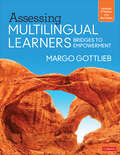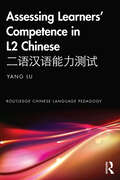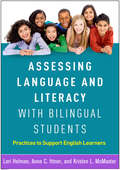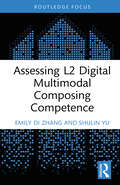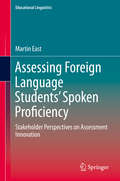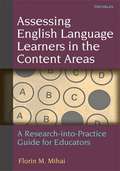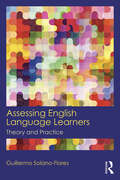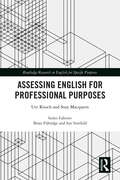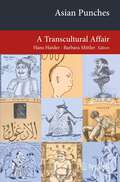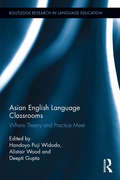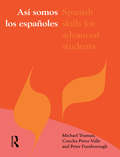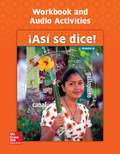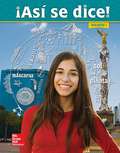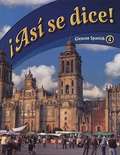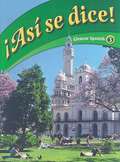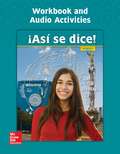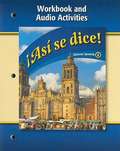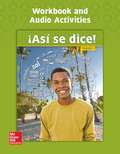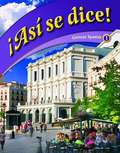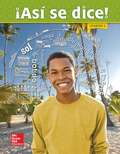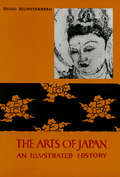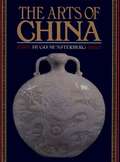- Table View
- List View
Assessing Multilingual Learners: Bridges to Empowerment
by Margo GottliebEmpowering multilingual learners, families, and teachers With its emphasis on relationship building as the backdrop for linguistically and culturally sustainable assessment, the bestselling second edition of Assessing Multilingual Learners significantly impacted the field of language education. Applying the groundbreaking assessment "as," "for," and "of" learning model to new contexts, this updated third edition offers educators welcoming and encouraging ways to support multilingual learners to succeed in school and beyond. Through eight thoroughly revised chapters, Dr. Margo Gottlieb ties assessment to teaching and learning to foster agency and empowerment for multilingual learners, families, and teachers. This book envisions assessment as a process integral to and embedded in curriculum and instruction through: Assets-based language Student-centered activities Classroom assessment tools Portraits of practice illustrating authentic assessment practices References and resources for stimulating discussion Deep questioning for thinking through processes, dilemmas, or challenges Assessing Multilingual Learners explores the realities and possibilities of classroom assessment as a road to inspire multilingual learners, their families, and teachers to reach great heights.
Assessing Learners’ Competence in L2 Chinese 二语汉语能力测试 (Routledge Chinese Language Pedagogy)
by Yang LuAssessing Learners’ Competence in L2 Chinese is the first book intended to answer the question on whether existing standardised and classroom-based assessments can reflect learners’ competence in L2 Chinese. The Chinese language has enjoyed increasing global popularity amongst second/foreign language learners and has become one of the major modern languages for school and university curricula. However, to many teachers and researchers, it has been difficult to answer with confidence whether the existing standardised and classroom tests can reflect learners’ competence in L2 Chinese. This book defines and redefines the constructs for assessing L2 Chinese competence that have been overlooked or misplaced because of the unique features of the Chinese language. The book provides theoretical backgrounds and practical methodologies for assessing competence in L2 Chinese trainees and experienced teachers of Chinese as a second language. It will provide invaluable guidelines and ready-made workshop materials for postgraduate teacher training programmes. Researchers and academics will find innovative frameworks on the subject for further studies and debates.
Assessing Language and Literacy with Bilingual Students: Practices to Support English Learners
by Lori Helman Anne C. Ittner Kristen L. McMasterFrom expert authors, this book guides educators to conduct assessments that inform daily instruction and identify the assets that emergent bilinguals bring to the classroom. Effective practices are reviewed for screening, assessment, and progress monitoring in the areas of oral language, beginning reading skills, vocabulary and comprehension in the content areas, and writing. The book also addresses how to establish schoolwide systems of support that incorporate family and community engagement. Packed with practical ideas and vignettes, the book focuses on grades K–6, but also will be useful to middle and high school teachers. Appendices include reproducible forms that can be downloaded and printed in a convenient 8 1/2" x 11" size.
Assessing L2 Digital Multimodal Composing Competence (Routledge Focus on Applied Linguistics)
by Emily Di Zhang Shulin YuThis book focuses on assessing L2 student digital multimodal composing (DMC) competence. It explores key themes, including the conceptualization of L2 student DMC competence, and the development, validation, and utilization of L2 student DMC competence in the tertiary context.Through a thorough review of the DMC literature, the book furnishes readers with a theoretical framework to comprehensively grasp the underlying constructs of L2 student DMC competence. It also provides a delineation of the process of scale development, i.e., defining constructs, constructing items, and analyzing items, scale validation, i.e., the structural, external, and consequential construct validity of the scale, and scale utilization in students’ DMC self- and peer-assessment practices.This practical guidance equips educators and practitioners with the necessary tools and strategies to effectively assess and enhance L2 students’ DMC competence. Scholars and professionals in the fields of L2 writing, language assessment, digital literacy, and technology-enhanced language learning will gain valuable insights from the content.
Assessing Foreign Language Students' Spoken Proficiency: Stakeholder Perspectives on Assessment Innovation (Educational Linguistics #26)
by Martin EastThis book presents an indepth study of assessment innovation and its impact on teaching and learning. The context is New Zealand, and the focus is additional languages other than English and the recent introduction of a radical new assessment of students' spoken proficiency, called interact. The book crosses the traditional theoretical and methodological boundaries associated with language testing research, which focuses on assessment performance, and presents an alternative approach where stakeholders become the centre of interest. It advances our understanding of how assessment innovation impacts on two key groups - teachers and students in schools - based on data collected from a substantial twoyear research project. It presents an account of these stakeholders' perceptions of the validity and usefulness of the new assessment in comparison with the more traditional test that it has replaced. Assessing Foreign Language Students' Spoken Proficiency makes an outstanding and original contribution to the field of second and foreign language teaching, providing a theory and research-based account of the development of a learner-centred approach to oral proficiency assessment. It is an important resource for teachers and teacher educators as well as assessment and curriculum specialists worldwide. It deserves to be widely read.
Assessing English Language Learners In The Content Areas: A Research-into-practice Guide For Educators
by Florin MihaiAssessing English Language Learners in the Content Areas: A Research-into-Practice Guide for Educators seeks to provide guidance to classroom teachers, staff developers, and test-item designers who want to improve ELL assessment outcomes, particularly in the areas of math, science and social studies. The first two chapters of the book establish the background for the discussion of content-area assessment for ELLs, examining several important characteristics of this rapidly growing student population (as well as critical legislation affecting ELLs) and providing a description of various forms of assessment, including how ELL assessment is different from the assessment of English-proficient students Important assessment principles that educators should use in their evaluation of tests or other forms of measurement are provided. Other chapters review ELL test accommodations nationwide (because, surprisingly, most teachers do not know what they can and cannot allow) and the research on the effectiveness of these types of accommodations. The book analyzes the characteristics of alternative assessment; it discusses three popular alternative assessment instruments (performance assessment, curriculum-based measurement, and portfolios) and makes recommendations as to how to increase the validity, reliability, and practicality of alternative assessments. The book proposes fundamental assessment practices to help content area teachers in their evaluation of their ELL progress.
Assessing English Language Learners: Theory and Practice
by Guillermo Solano FloresAssessing English Language Learners explains and illustrates the main ideas underlying assessment as an activity intimately linked to instruction and the basic principles for developing, using, selecting, and adapting assessment instruments and strategies to assess content knowledge in English language learners (ELLs). Sensitive to the professional development needs of both in-service and pre-service mainstream teachers with ELLs in their classrooms and those receiving formal training to teach culturally and linguistically diverse students, the text is designed to engage readers in viewing assessment as a critical part of teaching appreciating that assessments provide teachers with valuable information about their students’ learning and thinking becoming aware of the relationship among language, culture, and testing understanding the reasoning that guides test construction recognizing the limitations of testing practices being confident that assessment is an activity classroom teachers (not only accountability specialists) can perform Highlighting alternative, multidisciplinary approaches that address linguistic and cultural diversity in testing, this text, enhanced by multiple field-tested exercises and examples of different forms of assessment, is ideal for any course covering the theory and practice of ELL assessment.
Assessing English for Professional Purposes (Routledge Research in English for Specific Purposes)
by Ute Knoch Susy MacqueenAssessing English for Professional Purposes provides a state-of-the-art account of the various kinds of language assessments used to determine people’s abilities to function linguistically in the workplace. At a time when professional expertise is increasingly mobile and diverse, with highly trained professionals migrating across national boundaries to apply their skills in English-speaking settings, this book offers a renewed agenda for inquiry into language assessments for professional purposes (LAPP). Many of these experts work in high-risk environments where communication breakdowns can have serious consequences. This risk has been identified by governments and professional bodies, who implement language tests for gate-keeping purposes. Through a sociological lens of risk and responsibility, this book: provides a detailed overview of both foundational and recent literature in the field; offers conceptual tools for specific purpose assessment, including a socially oriented theory of construct; develops theory and practice in key areas, such as needs analysis, test development, validation and policy; significantly broadens the scope of the assessment of English for professional purposes to include a range of assessment practices for both professionals and laypeople in professional settings. Assessing English for Professional Purposes is key reading for researchers, graduate students and practitioners working in the area of English for Specific Purposes assessment.
Asian Punches: A Transcultural Affair (Transcultural Research – Heidelberg Studies on Asia and Europe in a Global Context)
by Barbara Mittler Hans HarderThis book deals with Punches and Punch-like magazines in 19th and 20th century Asia, covering an area from Egypt and the Ottoman Empire in the West via British India up to China and Japan in the East. It traces an alternative and largely unacknowledged side of the history of this popular British periodical, and simultaneously casts a wide-reaching comparative glance on the genesis of satirical journalism in various Asian countries. Demonstrating the spread of both textual and visual satire, it is an apt demonstration of the transcultural trajectory of a format intimately linked to media-bound public spheres evolving in the period concerned.
Asian English Language Classrooms: Where Theory and Practice Meet (Routledge Research in Language Education)
by Handoyo Puji Widodo Alistair Wood Deepti GuptaThe teaching of English in the Asian context is always challenging and dynamic because both teachers and learners have diverse linguistic and cultural backgrounds. Equally important, where English is not widely used outside the classroom, English language classrooms are an authentic site of learner engagement. For these reasons, for all those concerned with contemporary English language teaching (ELT) in Asia, Asian English Language Classrooms: Where Theory and Practice Meet, provides an account of theoretical orientations and practices in the teaching of English to multilingual speakers whose primary language is not English. While covering the fundamental ELT areas (e.g., the teaching of language skills, educational literature, the use of technology in ELT, the role of pragmatics in ELT, social psychology of the language classroom, and language classroom management) with which every language teacher and teacher trainer must be concerned, this volume showcases how particular orientations shape ELT practices. We believe that practicing English teachers must have a heightened awareness of the theory behind their practice. At the same time, the theoretical stance must be firmly anchored in actual classrooms. Containing newly commissioned chapters written by well-regarded and emerging scholars, this book will appeal not only to beginning teachers or teachers in training but also to established teachers around Asia where English is used as a lingua franca. If you are a student teacher of English or an English teacher who would like to see what other progressive teachers like you are doing across Asia, this is the book you have been looking for.
Asi somos los espanoles: Spanish Skills for Advanced Students
by Peter Furnborough Concha Pérez Valle Michael TrumanAsí somos los españoles provides advanced students with a genuine insight into Spanish culture via a range of practical activities and exercises. The courses includes many unscripted recordings of interviews with Spaniards from a variety of geographical areas. Students explore these recordings through activities designed to develop listening, speaking, reading and writing skills.This course suitable for classroom use or independent learning.
Asi Se Dice! Level 1 (Asi Se Dice)
by Conrad J. SchmittThis is the textbook for level 1 of the popular Spanish language learning series
Arts of Japan
by Hugo MunsterbergArts of Japan was originally published by Tuttle Publishing in print form in 1957.<P><P> This book," in the words of the author, "represents an attempt to fill a long-felt need for an account of the history of Japanese art which would deal with the crafts as well as with the so-called fine arts and carry the story of Japanese art up to the present day instead of ending with the death of Hiroshige." The reader will quickly perceive how well this aim has been achieved. Here, in a stimulating and informative text and 121 well-selected plates -12 in full colour-is a dynamic treatment of the various influences that have shaped the course of Japanese art history in the fields of painting, sculpture, architecture, and handicrafts. Discussed with challenging insight are the impact of the various Indian and Chinese schools, the pervasive influenceof Zen philosophy, and the many other artistic developments, giving the reader awell-rounded picture of the great significance and contribution of Japanese art. Special features of the book are sections on handicrafts and a chapter on prehistoric art. The book comes at a time when there is an awakened interest in Oriental art throughout the world. At the same time new methods of art research have been so expanded and refined that many interpretations of earlier writers have been made obsolete. Because of linguistic barriers, political upheavals, and the limited number of specialists, misconceptions have been especially numerous in the field of Oriental art. THE ARTS OF JAPAN admirably corrects these misinterpretations, consolidates the results of the most recent scholarship, and in one compact volume presents an up-to-date, authoritative survey of Japanese an throughout its long history and in all its colorful diversity.
The Arts of China
by Hugo MunsterbergThe arts of China are products of the world's oldest continuous artistic tradition as well as one of its most brilliant. In this stimulating work, noted Oriental art authority Dr. Hugo Munsterberg traces the history of Chinese art dynasty by dynasty, elucidating the origins and development of major movements in painting, ceramics, bronzes, sculpture, and architecture. He clearly describes and defines the important trends and influences that culminated in the brilliant sculpture of the T'ang, the enchanting landscape paintings of the Sung, and the exquisite ceramics of the Ming. Outstanding examples of each genre are presented in over one hundred superb color and black-and-white photographs.
